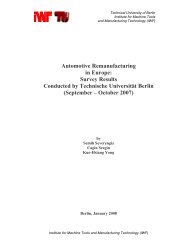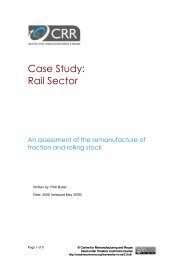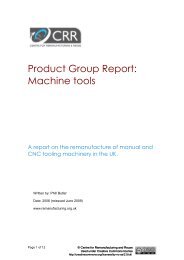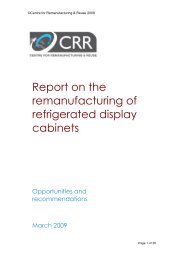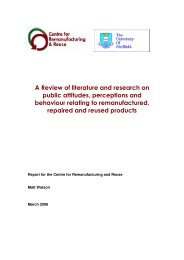Office Furniture - Centre for Remanufacturing & Reuse
Office Furniture - Centre for Remanufacturing & Reuse
Office Furniture - Centre for Remanufacturing & Reuse
You also want an ePaper? Increase the reach of your titles
YUMPU automatically turns print PDFs into web optimized ePapers that Google loves.
CENTRE FOR REMANUFACTURING & REUSE<br />
<strong>Reuse</strong> and Remanufacture<br />
of <strong>Office</strong> <strong>Furniture</strong><br />
Introduction<br />
Most people in offices do not give much thought<br />
to where the ubiquitous desk and chair came<br />
from, and probably less to its final disposal.<br />
The fact is that approximately 165,000 tonnes of<br />
office furniture is thrown away yearly from British<br />
businesses. Some of this will be the result of<br />
wear and tear, but the majority is in perfect<br />
working order and its disposal is largely due to<br />
changes in fashion, variations in staff levels, or<br />
whole office moves. We estimate that over 50%<br />
of office furniture sent to landfill each year is<br />
reuseable. Clearly this is a waste of both<br />
resources and money. To reduce the impact of<br />
waste office furniture, the <strong>Centre</strong> <strong>for</strong><br />
<strong>Remanufacturing</strong> and <strong>Reuse</strong> set up a year long<br />
collaborative project to identify and address<br />
some of the problems associated with reusing<br />
office furniture. The strategy was to look at all<br />
levels of the industry – engaging manufacturers,<br />
third-party reusers, the charitable sector and<br />
procurers. By addressing problems throughout<br />
the industry, we hope to begin the move to a<br />
more sustainable future. These pages give an<br />
overview of the successes of the project over<br />
the last twelve months.<br />
Further details of the project can be found on our<br />
website at www.remanufacturing.org.uk/furniture<br />
www.remanufacturing.org.uk
Rental<br />
Most office furniture is thrown away be<strong>for</strong>e it is broken or unusable.<br />
There are various reasons <strong>for</strong> this including varying staffing levels, the use of<br />
temporary staff <strong>for</strong> short term projects, changes in fashion or corporate style<br />
and office moves. The rental of office furniture is one solution to the problem of<br />
fluctuations in the amount of office furniture needed in a modern working<br />
environment. By renting, the office user specifies the need <strong>for</strong> office furniture, but<br />
does not specify how it is procured. The responsibility <strong>for</strong> the origin and disposal of<br />
the furniture is now transferred from the user to a rental company, whose profits<br />
are determined by maximising the use of these assets. For a rental company to<br />
maximise profitability, the reuse of office furniture is a key goal. This is<br />
achieved by a combination of straight reuse and remanufacture of old or<br />
worn units.<br />
We feel that rental is one way to minimise the waste of office<br />
furniture, particularly associated with short term projects or where<br />
ad-hoc teams need furniture <strong>for</strong> a brief period of time. This system<br />
works well in the USA where rental is seen as a intergral part of<br />
the overall furniture market. In the UK, however, the market is<br />
much smaller and attitudes to renting are less well explored. Cort<br />
<strong>Furniture</strong> Rental was commissioned to per<strong>for</strong>m a market survey to<br />
investigate the attitudes of office furniture procurers.<br />
“The conclusion was a culture to buy rather than rent – customers<br />
deemed renting as a secondary option rather than a main choice. Breaking<br />
down this barrier is now the focus of our ef<strong>for</strong>ts.”<br />
Tim Swaddle, Court <strong>Furniture</strong> Rental.<br />
The Role of Charities<br />
An important part of office furniture reuse has been the charitable sector. Over the<br />
last two decades this sector has grown in size, reach and complexity; a small number<br />
have focused exclusively on office furniture, although a great many sold office<br />
furniture in an as-and-when fashion. We have tried to examine the size and shape of<br />
this market to better understand how it can be further stimulated.<br />
The current economic downturn has affected this sector less than the corresponding<br />
commercial furniture market: the dependence on grants has shielded charities from<br />
some of the market problems, but this is currently both a risk and a stimulus to<br />
change. Some charities, social enterprises and indeed office furniture traders are<br />
reporting booming business. A great many others are struggling. The already low<br />
value of used furniture is further eroded by removal and storage costs.<br />
Many third sector organisations have weak balance sheets and are susceptible to<br />
market conditions. Couple this with business models dependent on grants and<br />
corporate largesse, and many organisations<br />
are scrambling to adapt.<br />
“The secondary office furniture market is undergoing significant change<br />
and none of the many diverse players will escape unchanged.”<br />
Dr David Bloomfield, lead on the Third Sector project.<br />
www.remanufacturing.org.uk/furniture Tel: 01296 337165
CENTRE FOR REMANUFACTURING & REUSE<br />
The Environmental Benefits<br />
We all ‘feel’ that reusing office furniture is the right thing to do. Reusing seems better<br />
than throwing away and buying new. From the perspective of waste reduction it<br />
clearly is. However, there are concerns that the energy to needed transport the<br />
reused furniture around the country and remanufacture/refurbish it may be higher<br />
than <strong>for</strong> buying new and there<strong>for</strong>e outweigh any benefit of reuse. To address this<br />
concern, we have calculated the carbon footprint <strong>for</strong> the production of a desk, seat<br />
and pedestal and the corresponding footprint required to remanufacture these three<br />
common office items.<br />
Our analysis looked at the energy required to source the wood, steel, plastic and<br />
other materials <strong>for</strong> production of the furniture and the energy required to ship and<br />
assemble the furniture <strong>for</strong> use. This was compared with the energy to collect,<br />
repair / remanufacture and deliver the furniture to a new site <strong>for</strong> use.<br />
“Although reuse seems better than throw-away, this work is important to<br />
ensure that we have this right.”<br />
Dr Adrian Chapman, Technical Consultant, Carbon Footprinting.<br />
Government Procurement<br />
Identifying and educating procurers in the benefits of reused office furniture is<br />
challenging, but could possibly lead to a significant increase in the level of reuse.<br />
Central government procures approximately 20% of the UK’s office furniture.<br />
Clearly this is a big target, and government has pledged to lead the way on<br />
sustainable procurement. Fortunately, Defra have recently updated the sustainable<br />
procurement specifications <strong>for</strong> office furniture. We have worked closely with Defra<br />
during this process and managed to secure a specification that requires all central<br />
government to procure 5% reused office furniture from April 2011.<br />
“The next stage in this process is to develop a set of training material that will<br />
help government procurers. This will continue beyond the project completion<br />
date but should deliver real change to the purchasing habits of Whitehall.”<br />
Dr Ben Walsh, project lead on sustainable procurement.<br />
Design <strong>for</strong> Remanufacture<br />
A range of designers, manufacturers and remanufacturers have worked together as a<br />
consortium in recognition of the important role that initial product design has upon the<br />
potential <strong>for</strong> cost effective remanufacture.<br />
<strong>Furniture</strong> has traditionally been designed <strong>for</strong> assembly. In order to secure cost<br />
effective remanufacturing, it is also necessary to take disassembly into account<br />
during the initial design – i.e. how can the components of interest be ‘harvested’ in<br />
the most cost effective manner at the end of each useful life. There is a wide range of<br />
issues to consider such as material selection, material weights and thicknesses,<br />
jointing techniques, component rationalisation and product / component longevity.<br />
The whole process can be greatly influenced by product services systems – i.e. the<br />
method of doing business.<br />
“We have helped address this ‘design <strong>for</strong> remanufacture’ by the development<br />
of a document that helps furniture designers appreciate how their actions can<br />
influence the end-of-life opportunities.”<br />
Dr Alistair Bromhead, British <strong>Furniture</strong> Manufacturer.<br />
info@remanufacturing.org.uk
CENTRE FOR REMANUFACTURING & REUSE<br />
Case Studies<br />
Although the market <strong>for</strong> remanufactured office furniture in the UK is small, there are organisations attempting to change this<br />
situation. <strong>Remanufacturing</strong> has flourished overseas leading to success in establishing long-term service and infrastructures.<br />
Three companies operating in the UK and overseas, which have a proven record in this area, were selected as examples of<br />
good practice. The examples show that to offer remanufactured product a different set of business principles need to be developed.<br />
The companies (based in Germany, USA and UK) offer a mixture of services and products, as well as a choice of both new and<br />
remanufactured furniture.<br />
Herman Miller (UK) and Wilkhahn (Germany) are recognised internationally as successful manufacturers of high quality office furniture<br />
who also offer take-back schemes and in-house reworking of their products. Both these organisations have achieved their success by<br />
combining classic design with design <strong>for</strong> end-of-life into their products. American company Kentwood <strong>Office</strong> <strong>Furniture</strong> differs slightly,<br />
as it supplies office furniture and do not manufacture directly. However, Kentwood gives customers the choice of new, reused and<br />
remanufactured furniture, and works to clients’ specific needs to create environments that combine the three.<br />
“These examples show that reuse and remanufacture are possible and that sustainably sourcing<br />
your office furniture does not mean that you have to compromise on quality.”<br />
Caroline Bartlett, lead on case study development.<br />
About the <strong>Centre</strong> <strong>for</strong> <strong>Remanufacturing</strong> and <strong>Reuse</strong><br />
The CRR has been <strong>for</strong>med to promote, where appropriate, the activities of remanufacturing and reuse. Our work is<br />
largely funded by Defra but we work with a range of regional agencies to reach our targets. We believe that<br />
remanufacturing and reuse are underused means of conserving resources; significant extra savings in materials and<br />
energy use are possible whilst boosting skills, employment and economic activity. Core to our purpose is the<br />
implementation of actions that will boost - in particular - remanufacturing. These policies and strategies are designed<br />
to help businesses (both consumers of remanufactured goods and remanufacturers), governmental policy makers,<br />
OEMs and trade bodies to deliver more remanufactured goods and thus reduce our impact on the environment, and<br />
at a profit. We generate the supporting in<strong>for</strong>mation that the remanufacturing industry needs to make its case and<br />
raise its profile.<br />
www.remanufacturing.org.uk





